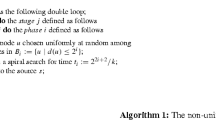Abstract
We consider the problem of patrolling—i.e. ongoing exploration of a network by a decentralized group of simple memoryless robotic agents. The model for the network is an undirected graph, and our goal, beyond complete exploration, is to achieve close to uniform frequency of traversal of the graph’s edges. A simple multi-agent exploration algorithm is presented and analyzed. It is shown that a single agent following this procedure enters, after a transient period, a periodic motion which is an extended Eulerian cycle, during which all edges are traversed an identical number of times. We further prove that if the network is Eulerian, a single agent goes into an Eulerian cycle within 2|E|D steps, |E| being the number of edges in the graph and D being its diameter. For a team of k agents, we show that after at most 2( 1 + 1/k) |E|D steps the numbers of edge visits in the network are balanced up to a factor of two. In addition, various aspects of the algorithm are demonstrated by simulations.
Similar content being viewed by others
References
Y. Afek, E. Gafni, Distributed
R. Aleliunas, R. M. Karp, R. J. Lipton, L. Lovász, C. Rackoff, Random Walks, Universal Traversal Sequences and the Complexity of Maze Problems, Proceedings of the 20th Annual Symposium on Foundation of Computer Science, pp. 218–223, 1979.
K. Knight, Are Many Reactive Agents Better than a Few Deliberative Ones, Proceedings of the International Joint Conference on Artificial Intelligence (IJCAI), pp. 432–437, 1993.
D. Hearn, M. Pauline Baker, Computer Graphics, Second Edition, Prentice Hall, 1994
S. Koenig, Complexity of Edge Counting, in: Goal-Directed Acting with Incomplete Information, Technical Report CMU-CS-97-199, School of Computer Science, Carnegie Mellon University, November 1997.
S. Koenig, R. G. Simmons, Easy and Hard Testbeds for Real-Time Search Algorithms, Proceedings of the National Conference on Artificial Intelligence, pp. 279–285, 1996.
S. Koenig B. Szymanski Y. Liu (2001) ArticleTitleEfficient and Inefficient Ant Coverage Methods Annals of Mathematics and Artificial Intelligence 31 IssueID1/4 41–76 Occurrence Handle10.1023/A:1016665115585
R. E. Korf (1992) ArticleTitleReal-Time Heuristic Search Artificial Intelligence 42 189–211 Occurrence Handle10.1016/0004-3702(90)90054-4
R. L. Rivest A. Shamir (1982) ArticleTitleHow to Reuse a “Write-Once” Memory Information and Control 55 1–19 Occurrence Handle0548.68046 Occurrence Handle10.1016/S0019-9958(82)90344-8 Occurrence Handle727734
R. Tarjan (1972) ArticleTitleDepth-First Search and Linear Graph Algorithms SIAM Journal on Computing 1 146–160 Occurrence Handle0251.05107 Occurrence Handle10.1137/0201010 Occurrence Handle304178
I. A. Wagner and A. M. Bruckstein, Cooperative Cleaners - a Study in Ant Robotics, in: A. Paulraj, V. Roychowdhry, C. D. Schaper - ed., Communication, Computation, Control and Signal Processing: A Tribute to Thomas Kailath, Kluwer Academic Publishers, The Netherlands, 1997
I. A. Wagner M. Lindenbaum A. M. Bruckstein (1998) ArticleTitleEfficiently Searching a Graph by a Smell-Oriented Vertex Process Annals of Mathematics and Artificial Intelligence 24 211–223 Occurrence Handle0930.68052 Occurrence Handle10.1023/A:1018957401093 Occurrence Handle1684642
I. A. Wagner, M. Lindenbaum, A. M. Bruckstein, Smell as a Computational Resource—a Lesson We Can Learn from the Ants, Proceedings of ISTCS ‘96, Jerusalem, pp. 219–230, 1996.
I. A. Wagner M. Lindenbaum A. M. Bruckstein (1999) ArticleTitleDistributed Covering by Ant-Robots Using Evaporating Traces IEEE Transactions on Robotics and Automation 15 918–933 Occurrence Handle10.1109/70.795795
I. A. Wagner, M. Lindenbaum, A. M. Bruckstein, On-Line Graph Searching by a Smell-Oriented Vertex Process, AAAI-97, Workshop on On-Line Search, Providence, RI, 1997.
Author information
Authors and Affiliations
Corresponding authors
Additional information
Communicated by N. Megiddo.
Rights and permissions
About this article
Cite this article
Yanovski, V., Wagner, I. & Bruckstein, A. A Distributed Ant Algorithm for\protect Efficiently Patrolling a Network. Algorithmica 37, 165–186 (2003). https://doi.org/10.1007/s00453-003-1030-9
Received:
Revised:
Published:
Issue Date:
DOI: https://doi.org/10.1007/s00453-003-1030-9




